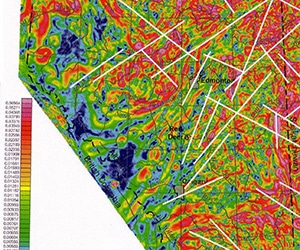In an article published in E&P magazine, Henry Lyatsky, of Lyatsky Geoscience Research & Consulting Ltd. makes the case for using gravity and magnetic geophysical methods in oil exploration. He cautions that: where useful gravity and magnetic data are disregarded, risk reduction is incomplete, and the results of exploration programs are less reliable.

Gravity and magnetic methods are an essential part of oil exploration. They do not replace seismic. Rather, they add to it. Despite being comparatively low-resolution, they have some very big advantages. At a comparatively low cost, airborne potential field surveys can provide coverage of large areas. Allowing quick regional coverage, even gravity surveys can now be recorded from an aircraft with fairly high reliability.
In the article, Lyatsky explains the meaning of anomalies. The physical rock property that links gravity anomalies to rock composition is density, explains Lyatsky. The rock property that links magnetic anomalies to rock composition is total magnetization. Thus, each potential-field method valuably provides its own picture of the subsurface. Being responsive to lateral variations in rock properties, gravity and magnetic methods are best suited for detecting steep discontinuities such as faults. Seismic methods, by contrast, are best for detecting vertical rock variations and low-angle discontinuities such as layer boundaries.
Two examples of exploration use are provided to illustrate the effective application of gravity and magnetic methods: The southern and central Alberta Basin, where gravity and magnetic data can be processed specifically to highlight subtle lineaments; and the horst and graben offshore Queen Charlotte Basin, where land and offshore magnetic data were instrumental in the delineation of extrusive and intrusive igneous rocks.
Lyatsky closes with an appeal for gravity and magnetics experts in oil exploration to think like their clients, who tend to be geologists and seismologists – and to present their work from first principles, with minimum mathematics and with maximum geological consideration. Only then, writes Lyatsky, can interdisciplinary walls be brought down so that exploration managers can vividly see the essential practical utility of gravity and magnetic methods.
Read the full article on E&P Magazine.




